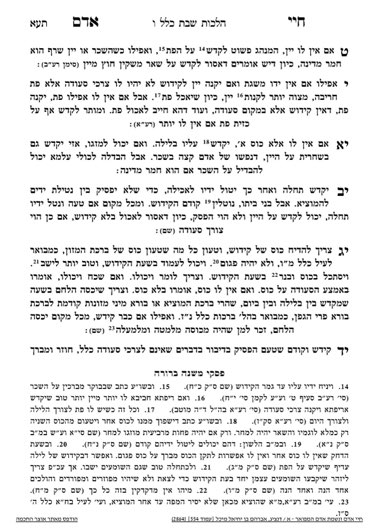The current series, which will cover Maariv on Friday night and Kiddush, is available for sponsorship. Please contact Rabbi Reingold for more information.
We are beginning siman 13. The Chayei Adam begins with some of the halachos of the kos itself. The Gemara says that the kos should be washed inside and outside. Therefore, if another person had used the kos previously, one should be careful to wash it.
The Chayei Adam sends the learner back to Klal 46, where he discusses other points of note. Over there, in siman 7, he writes that the 1) kos must be fully intact, 2) without any cracks. Even the bottom stand should be intact, and the kos should not be used if it is not intact, even if the stand does not hold any liquid. 3) If there are any cracks or nicks in the lip, or if any of the walls are missing, it should not be used. If there is a crack, even if nothing is missing, it should not be used unless one has no other choice.
4) The kos should be filled to the top. 5) When accepting (or picking up a kos), one should take it in two hands, 6) raise it a tefach over the table, and 7) remain focused while holding the kos.
8) The wine should not be pagum. Pagum refers to wine from which someone has already taken a drink. For example, one cannot reuse their leftover wine in the kos from Friday night for Shabbos day. Obviously, the wine in the bottle is not affected. However, one can relieve the issue of pagum by adding more wine or even water to the kos.
The Mishnah Berurah writes that if one has no other option, on Friday night they should rather recite kiddush on bread and then use the non-pagum wine Shabbos day. If one did not do so, then on Shabbos day, left with no other choice, one would recite kiddush on the pagum wine. Nevertheless, we see how important pagum is, as the Mishnah Berurah holds one should rather make kiddush on bread when possible.
Similarly, when a person drinks from the kiddush wine, it should not be pagum. We solve this issue by having the person making kiddush pour out wine into other cups before drinking himself. If he drinks before pouring out, what he is offering is pagum. Nevertheless, if people don’t mind, we say that in the same way a person drinks multiple times out of the same cup, even if there are time lapses between them, if multiple people are drinking from the same kos, it is not considered pagum. If it was not pagum for the first person (e.g., the person making kiddush), it is not pagum for others either. This is only true if they drink from the same cup as the mekadaish. If they switch it into their own cups, it is considered pagum and we cannot rely on the previous leniency that the guests are all considered drinking as one. So if a husband sends the kiddush cup to his wife, if she drinks from his cup, she is included in the previous leniency. If she pours it into her own cup, it is considered pagum.
The idea of other people drinking from the kiddush is not a halachic requirement, but a hiddur that many people have taken on. It is considered special to drink from a kos shel bracha. Therefore, although a woman who pours out from her husband’s cup into her own is not yotzei, it is also not meakeiv, because she doesnt have to drink. In a lechatchilla scenario, one must be careful it is not pagum.
On the other hand, if she is going to drink from his cup, she may not always be allowed to, as it is assur for her to share a cup with her husband when she is a niddah. Thus, he should pass out cups of wine before drinking. The husband can not pass a cup of wine directly to her, though.
Alternatively, she can take the cup but she would have to keep it. She could also pour the wine into her own cup and then add a small amount of water, thereby removing the pagum status.
Summary
- The kos should be washed inside and outside.
- The kos should be fully intact, without any dents or scratches.
- One should not use pagum wine for kiddush.
- Pagum refers to wine from which another person already drank.
- Pagum status can be removed by adding either wine or water to the cup.
- The listeners should drink wine lechatchilah.
- Similar to the mekadaish, the wine they drink should not be pagum.
- One solution is to pour the kiddush out into another cup before the mekedaish drinks. They will then take wine from that cup, which has not been drunk from.
- There is a heter that allows for multiple people to drink from the same cup, and it is not pagum, because it is understood to be a continuation from the original drinking of the mekadaish.



